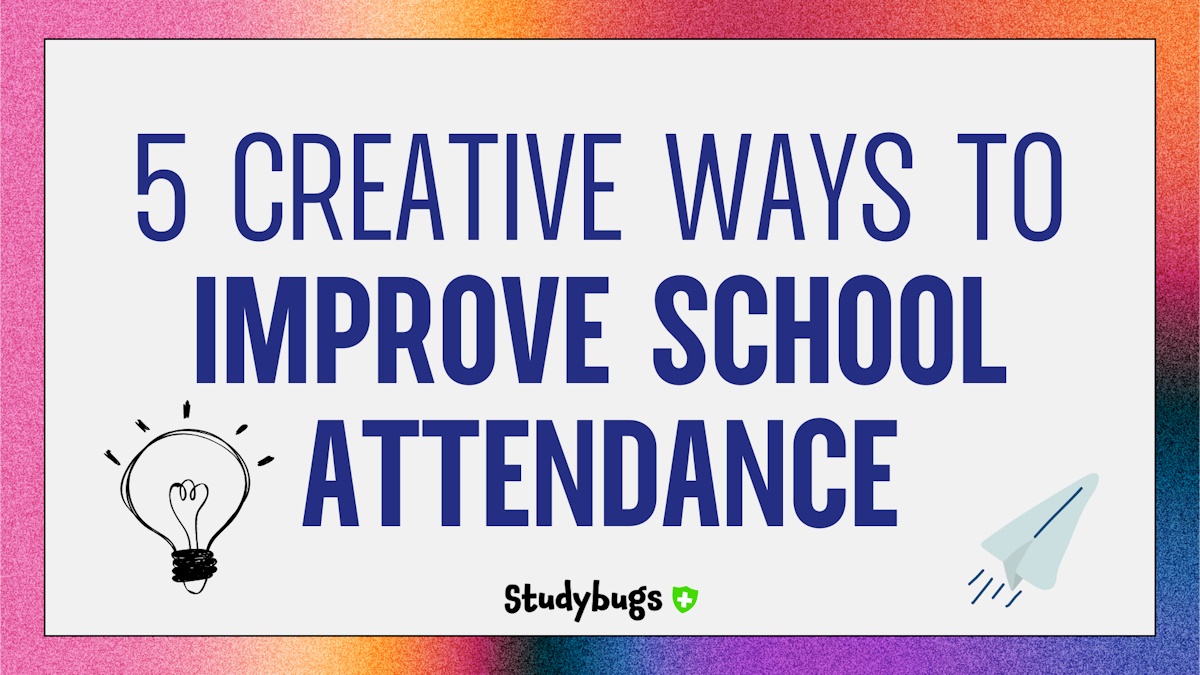Explore insights, updates and real-world impact from across the Studybugs community. From school absence trends to public health innovation, our blog shares stories and ideas that help keep children happy, healthy and in school.
5 Creative Ways to Improve School Attendance

Improving school attendance is no easy feat. And with school attendance yet to fully recover since Covid, schools are understandably looking for new and creative ways to improve attendance.
If that’s why you’re here, you’ve come to the right place. These innovative approaches to improving attendance will take you beyond the obvious solutions, helping you to think about motivating pupils, building strong relationships and understanding how attendance fits into your wider school culture.
So without further ado, here are five creative ways to improve school attendance.
Create an Awesome School Culture
Good attendance doesn’t happen in isolation. It’s related to the quality of your school’s curriculum, ethos, behaviour and inclusivity. Building an awesome school culture is a great way to encourage and reward good attendance.
For example, we’ve heard about a school that noticed they had lower attendance on Fridays. So they started serving pancakes and waffles at their breakfast club to increase Friday attendance. This school also put core subjects on Fridays so pupils knew it was as important to attend on Friday as any other day.
Help Pupils Find Meaningful Involvement
Many successful schools emphasise the connection between attendance, academic success, and future opportunities. To take this to the next level, try coupling this with a more immediate purpose for pupils to attend.
Maybe that’s being in charge of stage lights for the school play, joining the netball team, or starting a video games club at lunchtime. Giving pupils responsibility helps them feel empowered and accountable to others. They’ll be engaged and encouraged to attend school when they feel like they have a purpose.
Build Strong Relationships
Schools that successfully secure good attendance understand that attendance is everyone’s responsibility, not just that of your attendance officer or deputy head. Ensuring staff understand their roles means they can build positive relationships with pupils.
Pupils also report that having a consistent person they feel they can talk to makes a huge difference. Whether that’s a class teacher, a teaching partner, school nurse, if pupils have a strong relationship with a staff member, that staff member can broach difficult subjects with them like attendance.
The same goes with parents. It’s important to establish trust with parents so that when you have to have difficult conversations, they’re more likely to accept what you have to say.
For example, school leaders could build relationships with pupils by greeting them at the start of each day. Having a positive interaction with pupils (and not being someone who just admonishes them about uniform or being late) helps build that relationship.
One final relationship to foster is between pupils themselves. You could introduce a mentor programme where older pupils support younger pupils, or a peer-to-peer system where pupils feel accountable to each other. These relationships have many benefits, helping older pupils feel responsible and younger children supported, again giving them a reason to come to school.
Gamification
Gamification is the concept of adding game mechanics into nongame situations. This could be something like attendance awards or an attendance “streak” of consecutive days.
These ideas are already in place in many schools, but need to be taken with a grain of salt as they can carry negative connotations – such as children feeling additional pressure and anxiety to achieve 100% attendance.
A more creative way to use rewards in your attendance strategy is to make them adaptable. Think about them on a case-by-case basis, using rewards for persistent absentees who make improvements or positive reinforcement for pupils returning from a part-time timetable.
Minimise Obstacles
Addressing the underlying reasons for absence is key to improving attendance.
That’s no secret, but identifying these obstacles can take some effort.
Part of that comes down to effectively analysing attendance data. Do pupils miss certain days regularly? Is a particular subject causing them anxiety? Mock exams? Using tools like Studybugs Attendance can help you identify patterns of absence, helping you intervene early.
One key thing to think about is whether you can pre-empt these issues. Could you put on a special breakfast club for exam-year pupils on days when they have mocks? Bring in a therapy dog? Have a post-exam pizza party? Plan a staff-student cricket match?
Involving pupils in these decisions is a great way to find out what would motivate them to attend and help them feel comfortable.
Of course, some obstacles to attendance aren’t as obvious. Reasons like bullying or embarrassment about clothes may not have clear patterns, but that’s why it’s so important to build trust and empathy, as outlined above.
Bonus: Free Posters!
Here’s one final idea for how to improve attendance creatively: get creative with your existing practices and resources.
For example, many schools put up displays to encourage good attendance. But these are often covered in graphs or are very text-heavy, making them difficult for pupils and parents to engage with at a glance.
So we created some fun, creative posters that demonstrate the impact of school absence in terms pupils will respond to. Check them out here.
Time to Get Creative
Improving attendance in today’s environment requires creative thinking and planning.
You may need to experiment, be willing to try something and adapt. But by concentrating on your school’s culture and pupil wellbeing, you can make school a place children genuinely want to be.
So there you have it – five creative ways to improve attendance (plus a bonus). Enjoy getting creative!
— Lucas Abbott